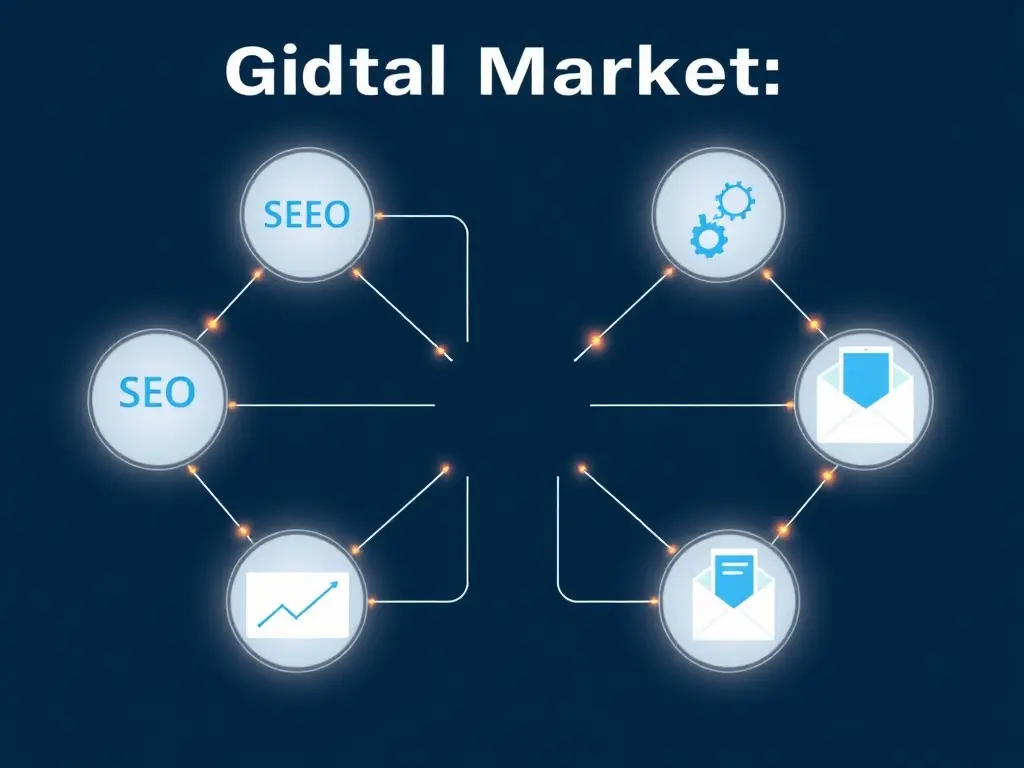What Is Digital Marketing?
Today’s world is rapidly moving towards digitalization, and businesses are no exception. In this context, the term Digital Marketing has become one of the most crucial concepts for growth and success. But what exactly is digital marketing? In simple terms, digital marketing refers to the set of marketing activities and strategies conducted through digital channels and tools like the internet, search engines, social media, email, and mobile applications to connect with current and potential customers. Unlike traditional marketing, which relied on billboards, television ads, and print, online marketing enables two-way interaction, precise audience targeting, and data analysis at a significantly lower cost. Today, the application of digital marketing goes beyond mere advertising and has become the core of the business strategies of many successful companies.
Why Has Digital Marketing Become So Important?
The shift from traditional to digital marketing is not a choice but a necessity. The importance of this field can be examined from several aspects. Firstly, your audience is online. People spend a significant portion of their day on the internet, from searching on Google to browsing Instagram. online marketing allows you to be exactly where your customers are. Secondly, it is highly targeted. You can show your ads only to people with specific demographic characteristics (age, gender, location) or particular interests. This means less wasted resources and a higher return on investment (ROI). Finally, everything in the digital world is measurable. You can precisely understand how many people saw your ad, how many clicked on it, and how many converted into customers. This data is vital for continuous campaign optimization and making smart decisions.
A Brief Comparison: Digital vs. Traditional Marketing
- Reach: Traditional marketing is limited to a specific geography, while digital marketing has a global reach.
- Cost: Digital advertising costs are often much lower than television, radio, or print ads.
- Targeting: Targeting in digital marketing is highly precise and data-driven, whereas it’s very broad in traditional methods.
- Interaction: Digital marketing allows for direct, two-way interaction with the audience, while traditional marketing is a one-way communication.
- Measurement: Results in digital marketing are accurately and instantly measurable, but assessing effectiveness in traditional methods is difficult and approximate.
The Core Components and Key Channels of Digital Marketing
Digital marketing is an umbrella term that encompasses numerous sub-disciplines. Each of these channels has its own specific use and strategy, and they are often used in an integrated manner to achieve the best results. Below, we introduce the most important ones.
1. Search Engine Optimization (SEO)
SEO is the process of optimizing your website to rank higher in search engine results pages (SERPs) like Google. The main goal of SEO is to increase organic (free) traffic to your site. When a user searches for a term related to your business, SEO helps your site appear among the top results. This process includes three main parts: On-Page SEO, Off-Page SEO, and Technical SEO.
2. Content Marketing
Content marketing is a strategic approach focused on creating and distributing valuable, relevant, and consistent content to attract and retain a clearly defined audience. The ultimate goal is to drive profitable customer action. Content can be produced in various formats, such as blog posts, videos, podcasts, infographics, and e-books. Content marketing is the foundation and fuel for other online marketing activities, especially SEO and social media marketing.
3. Social Media Marketing (SMM)
This channel involves using social platforms like Instagram, LinkedIn, Twitter, etc., to promote a brand, product, or service. Its primary applications are increasing brand awareness, building a loyal community of followers, driving traffic to the website, and even direct sales. Social media marketing requires creating engaging content tailored to each platform, consistent interaction with users, and running targeted advertising campaigns.
4. Pay-Per-Click (PPC) Advertising
PPC is a model of online advertising in which advertisers pay a fee each time one of their ads is clicked. The most famous example is Google Ads. In this method, you can display your ads on search engine results pages, other websites, and apps to a target audience and only pay when a user is interested in your ad and clicks on it. This method is highly effective for achieving quick results and attracting immediate traffic.
5. Email Marketing
Email marketing is one of the oldest and still one of the most effective digital marketing tools. This method involves sending commercial messages to a group of people via email. Its main use is to maintain relationships with customers, inform them about new products and discounts, nurture leads, and increase customer loyalty. Unlike social media, where algorithms control the content, your business fully controls your email list, making it a valuable asset.
Practical Applications of Digital Marketing for Today’s Businesses
Now that we are familiar with the definition and components of digital advertising, let’s see what practical applications this powerful tool has and how it can help businesses grow, from small, one-person startups to large corporations.
Increasing Brand Awareness and Building Trust
One of the first and most important applications of digital advertising is introducing your brand to a wide audience. By using content marketing, SEO, and social media activity, you can establish your brand as a credible and expert source in your field. Creating educational and useful content shows the audience that you are not just thinking about selling but care about solving their problems. Over time, this process builds trust and makes your brand name memorable to users.
Acquiring New Customers at an Optimal Cost
Digital marketing tools like targeted ads on Google and social media allow you to deliver your message precisely to those who are most likely to become your customers. This significantly reduces marketing costs and increases the return on investment. Additionally, through SEO, you can drive a steady stream of potential customers who are actively looking for your products or services to your site.
Enabling the Launch and Growth of Solo Businesses
Perhaps one of the most attractive applications of digital advertising is the democratization of entrepreneurship. Today, an individual with a good idea and digital marketing knowledge can single-handedly launch and monetize a complete business. Tools like WordPress for building a website, Instagram for marketing, and freelance platforms exist. A solo entrepreneur can build their personal brand, sell products, or offer services without needing substantial initial capital.
Analyzing Data for Smart Decision-Making
Every activity in the digital world generates data. Analytical tools like Google Analytics show you how users entered your site, which pages they visited the most, how long they stayed, and at what stage of the purchase process they left. Analyzing this data helps you identify the strengths and weaknesses of your strategy, understand customer behavior, and make future decisions based on real evidence rather than guesswork.
Conclusion: Digital Marketing, the Master Key to Success in the Digital Age
In summary, digital marketing is no longer a luxury option or a peripheral part of a business; it is the driving engine of growth, customer communication, and survival in today’s competitive market. From increasing brand visibility to acquiring loyal customers and accurately analyzing their behavior, the applications of digital advertising cover all aspects of a modern business. Whether you are a solo entrepreneur or the marketing manager of a large company, investing in learning and implementing the right digital advertising strategies is the smartest decision you can make for the future of your business. Now is the time to take the first step, define your goals, and start your digital journey by choosing the right channels.
Sources
- What is Digital Marketing? A Complete Guide to Digital Marketing – Dr. Mostafa Najafi
- All About Digital Marketing – Shanbe Mag
- History of Digital Marketing – Marketing Iran Talent
- Digital Marketing Tools for a Solo Business – YouTube
- Complete Digital Marketing Training – Sari Asan
- Guide to Social Media Marketing – RayanIT






